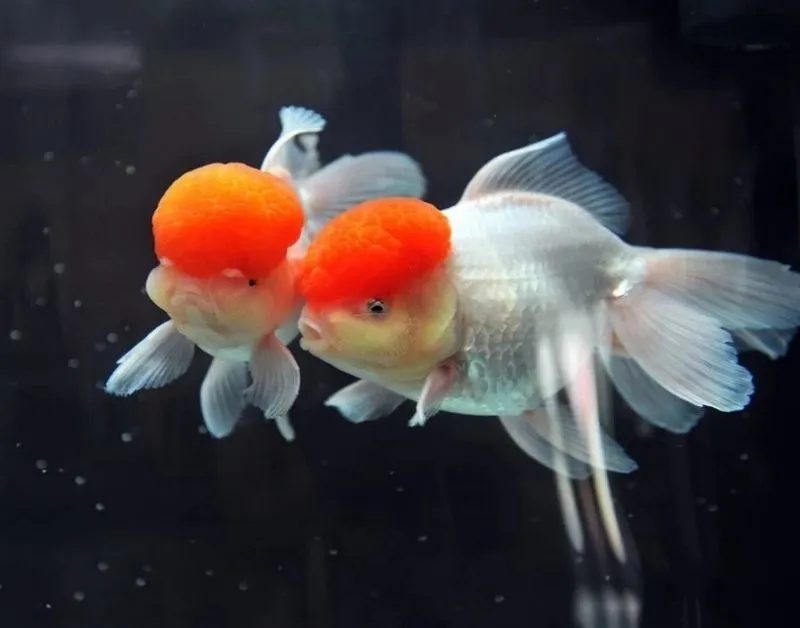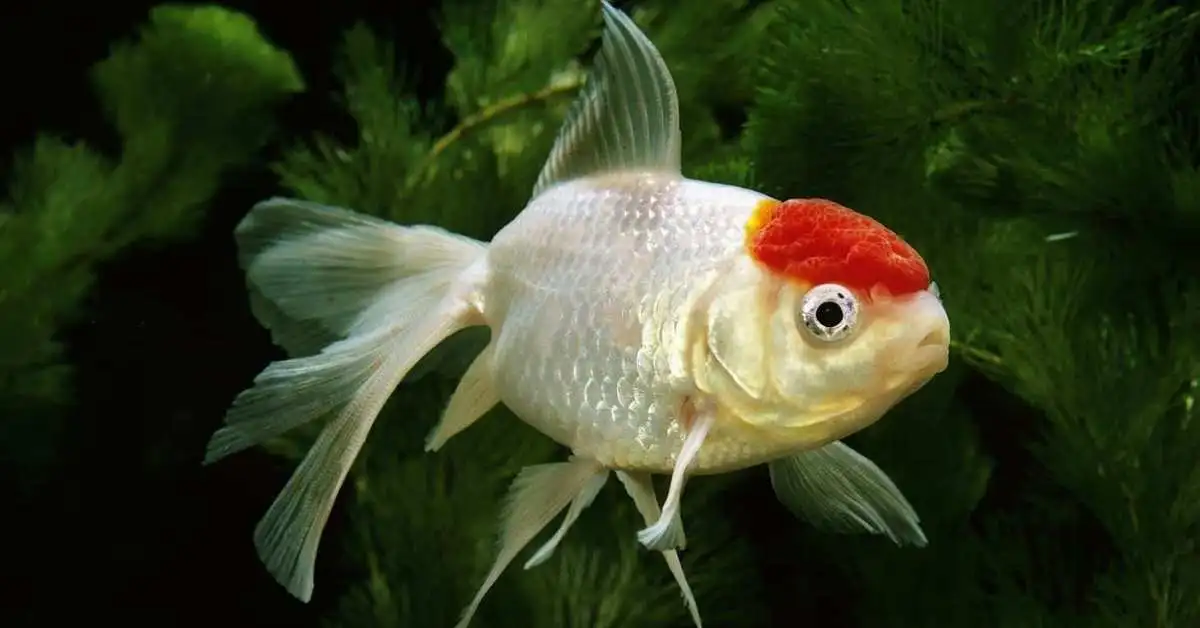Oranda Goldfish
Oranda Goldfish are captivating freshwater fish that enhance any aquarium with their beauty. Their distinctive head shape, known as the wen, and vibrant colors make them eye-catching. These fish exhibit charming behaviors and have a gentle, peaceful temperament, making them ideal for community tanks. Their unique appearance and personality have made them popular among aquarists. Observing Oranda Goldfish swim gracefully is a delightful experience that captivates both beginners and seasoned fish enthusiasts. They truly bring a rare element of beauty to aquatic displays. The color of this goldfish can be in different varieties like red orange, black, yellow etc.

Lifespan And Size of Oranda Fish:
With good care and proper housing conditions, Oranda Goldfish Can live up to about 15 years, if kept in a large pond, they can live up to about 20 years. Their lifespan depends largely on the quality of care provided by their owner. If kept in poor water and confined spaces, these fish can suffer from disease and even premature death. In order to grow, their owner has to take good care of them so that they live a good life. Its size is about eight to nine inches in length when fully grown. With the right care and space, these fish can reach their full potential size, adding a charming presence to aquariums.
Breeding of Oranda Goldfish:
Breeding Oranda Goldfish is not difficult. They happily breed in pairs and groups of five fish. Create a separate breeding tank in the same condition as the main aquarium. The only difference with this tank is that it should have fine-leaf plants. Fish will lay eggs on these leaves. You can also use a spawning mop. Before breeding, keep the fish in a separate tank and then prepare them with live food. When you transfer them to a breeding tank, the fish will breed in the early hours of the morning. The fish will chase each other and intensify their color before breeding.
Physical Description of Oranda Goldfish:
The Oranda Goldfish looks very different from normal goldfish, with unique features and colors that make it special. They have an egg-shaped body, with a wide belly that distinguishes them from the typical skinny goldfish. All of the Orandas fins are in pairs, except for the dorsal fin, which allows it to move slowly and gracefully through the water.
The most beautiful feature is the tail fin, which spreads out into four branches and gives them a graceful appearance while swimming. Oranda’s most distinctive symbol is the cap on his head, also known as the “Ven” or “Crown”. This rough cap begins to appear at three to four months of age but is fully developed by two years.
Housing Requirement Of Oranda Goldfish:
Aquarium size of Oranda Goldfish :
Like other goldfish, Oranda goldfish are not fast swimmers, but they still need a lot of space to live in captivity. Most experts say that this fish can live well in a 20-gallon tank, but we consider that to be a minimum standard. We recommend that a 30-gallon tank is a healthy and comfortable tank for your goldfish. The extra space plays an important role in improving their quality of life while living a healthy and comfortable life.
Water Parameters
The Oranda Goldfish does not occur naturally. Unlike other tropical freshwater fishes, there is no wild counterpart with which water parameters can be compared.
Fortunately, the needs of this fish are well known among aquarium enthusiasts. Most of the basic parameters are modeled from wild carp characteristics. Oranda likes relatively cool water and normal pH levels. It’s worth noting that this fish can tolerate small changes, so it doesn’t have to be perfect.
However, you need to stay within acceptable limits. Orandas are more sensitive to temperature than typical goldfish, so buy an accurate thermometer and monitor the water.
Stick to the parameters below and your fish will thrive optimally:
- Water temperature: 65°F to 72°F (aim for the mid-range)
- pH levels: 5.0 to 8.0 (a neutral pH of around 7.0 is best)
- Water hardness: 4 to 20 dGH
Completing the Aquarium Setup of Oranda Goldfish:
Decoration:
The Oranda Goldfish is not too picky when it comes to decorations, making the process quite simple. These look great in natural tank setups, but you can also add some unique decorations if you like. Your goal is to create a safe environment that does not interfere with the fish’s ability to swim freely. Add fine sand to the bottom of the tank because Orandas like to dig. Pebbles or rough surfaces can be harmful to them.
Plants:
The next step is to add some sturdy plants. Oranda goldfish do well in a tank with plants, but it is best to use plants with strong leaves.
There are two reasons why stronger plants are better:
- The first is that plants with light leaves can move with the flow of water, impeding the swimming of fish. Allowing space for free movement is important.
- Second, orandas can deposit sand on nearby plants while digging. Delicate plants can be damaged by this process. You can also use plastic or silk plants.
- In addition to the decor, consider oxygen. Oranda goldfish like water with high oxygen levels. You can achieve this through your filtration system or by installing an air builder.
Food and Diet of Oranda Goldfish:
Oranda goldfish have no special dietary requirements. These are avomors, so feeding them is easy!
It accepts dry fluxes and pellets without any problem. You can also give balanced vegetables such as spinach or salad with dry food. High protein snacks, such as brine shrimp, bloodworms, tubifex worms, etc… are also great to have to offer your fish and try to give it a variety of foods. In this way, it will receive all the necessary nutrients, and if your fish has a color problem, it can eliminate that color problem too.
Behavior & Temperament of Oranda Goldfish:
Like other fancy goldfish, Orandas are very peaceful. These are slow-moving fish that do not cause any problems at all. It spends most of its time slowly floating in the tank. You may sometimes see them digging in dry material or examining plants. Orandas are not powerful swimmers, but they are energetic. They like to be active throughout the day. Like other fish, orandas don’t spend much time hiding. This means you will never get bored watching them and will always be curious to know what they are up to!
Tank Mates of Oranda Goldfish:
Oranda goldfish can get along with other peaceful fish that are similar in size. However, it is always important to choose tank mates carefully to avoid potential problems.First, avoid small fish. These goldfish often mistake small fish for food. It’s also best to avoid fast-swimming or fin-chewing fish, as they can damage your precious Oranda.
Best tank mates would be other Oranda goldfish. Many owners choose different color versions to add visual interest. You can also choose larger fish that have a peaceful disposition like the Oranda Goldfish.
Common potential diseases of Oranda Goldfish:
Oranda goldfish, just like other freshwater fish, are prone to diseases, such as ichthyosis. Eczema is an infectious disease and stress is the reason for the disease may suffer from itch when water conditions are not optimal. Large changes in pH balance and temperature can cause itch, as can a lack of adequate filtration. When an aquarium is dirty, ammonia and nitrate levels can become very high. To avoid this, check the filter regularly and do a 25 percent water change every few weeks.
Oranda goldfish can also have problems with their special cap. In most cases, their head growth remains manageable. However, occasionally it can grow so large that it obstructs the fish’s vision and makes it difficult for them to eat. Some medications can help with this problem. These prevent further growth of the cap, ensuring a comfortable life for your fish.
Price and Cost of Oranda Goldfish:
- Juvenile Oranda Goldfish: $10 – $30
- Adult Oranda Goldfish: $30 – $100
- Rare Color Variants: $100 – $300 (or more, depending on rarity and demand)
Conclusion:
Oranda Goldfish are captivating freshwater fish that enhance any aquarium with their beauty. Their distinctive head shape, known as the wen, and vibrant colors make them eye-catching. They have an egg-shaped body, with a wide belly that distinguishes them from the typical skinny goldfish.Oranda is available in various beautiful colors. It is usually bright orange or yellow in color, but some people like Black Oranda, whose deep black color makes it attractive. Orandas are very peaceful. These are slow-moving fish that do not cause any problems at all. It spends most of its time slowly floating in the tank.







